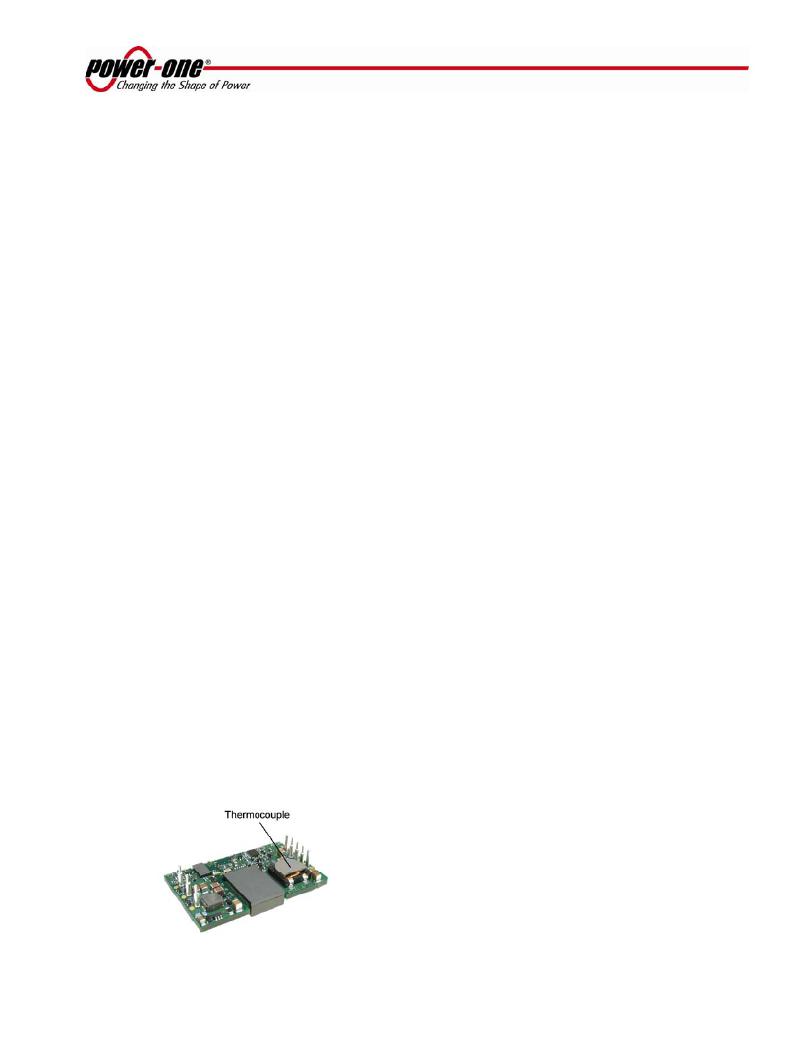- 您现在的位置:买卖IC网 > Sheet目录875 > QME48T40050-NGA0 (Power-One)DC/DC QUARTER BRICK 5V OUT
�� �
�
 �
�QME48T40050� DC-DC� Converter� Data� Sheet�
�36-75� VDC� Input;� 5.0� VDC� @� 40� A� Output�
�Characterization�
�General� Information�
�The� converter� has� been� characterized� for� many�
�operational� aspects,� to� include� thermal� derating�
�(maximum� load� current� as� a� function� of� ambient�
�temperature� and� airflow)� for� vertical� and� horizontal�
�mountings,� efficiency,� startup� and� shutdown�
�parameters,� output� ripple� and� noise,� transient�
�response� to� load� step-change,� overload,� and� short�
�circuit.�
�The� following� pages� contain� specific� plots� or�
�waveforms� associated� with� the� converter.� Additional�
�comments� for� specific� data� are� provided� below.�
�Test� Conditions�
�All� data� presented� were� taken� with� the� converter�
�soldered� to� a� test� board,� specifically� a� 0.060”� thick�
�printed� wiring� board� (PWB)� with� four� layers.� The� top�
�and� bottom� layers� were� not� metalized.� The� two� inner�
�layers,� comprised� of� two-ounce� copper,� were� used� to�
�provide� traces� for� connectivity� to� the� converter.�
�The� lack� of� metalization� on� the� outer� layers� as� well�
�as� the� limited� thermal� connection� ensured� that� heat�
�transfer� from� the� converter� to� the� PWB� was�
�minimized.� This� provides� a� worst-case� but� consistent�
�scenario� for� thermal� derating� purposes.�
�All� measurements� requiring� airflow� were� made� in� the�
�vertical� and� horizontal� wind� tunnel� using� Infrared� (IR)�
�thermography� and� thermocouples� for� thermometry.�
�Ensuring� components� on� the� converter� do� not�
�exceed� their� ratings� is� important� to� maintaining� high�
�reliability.� If� one� anticipates� operating� the� converter�
�at� or� close� to� the� maximum� loads� specified� in� the�
�derating� curves,� it� is� prudent� to� check� actual�
�operating� temperatures� in� the� application.�
�Thermographic� imaging� is� preferable;� if� this�
�capability� is� not� available,� then� thermocouples� may�
�be� used.� The� use� of� AWG� #40� gauge� thermocouples�
�is� recommended� to� ensure� measurement� accuracy.�
�Careful� routing� of� the� thermocouple� leads� will� further�
�minimize� measurement� error.� Refer� to� Fig.� H� for� the�
�optimum� measuring� thermocouple� location.�
�Fig.� H:� Location� of� the� thermocouple� for� thermal� testing.�
�Thermal� Derating�
�Load� current� vs.� ambient� temperature� and� airflow�
�rates� are� given� in� Fig.� 1� and� Fig.� 2� for� vertical� and�
�horizontal� converter� mountings.� Ambient� temperature�
�was� varied� between� 25� °C� and� 85� °C,� with� airflow�
�rates� from� 30� to� 500� LFM� (0.15� to� 2.5� m/s).�
�For� each� set� of� conditions,� the� maximum� load� current�
�was� defined� as� the� lowest� of:�
�(i)� The� output� current� at� which� any� FET� junction�
�temperature� does� not� exceed� a� maximum�
�specified� temperature� of� 120� °C� as� indicated� by�
�the� thermographic� image,� or�
�(ii)� The� temperature� of� the� inductor� does� not�
�exceed� 120� °C,� or�
�(iii)� The� nominal� rating� of� the� converter� (40� A).�
�During� normal� operation,� derating� curves� with�
�maximum� FET� temperature� less� or� equal� to� 120� °C�
�should� not� be� exceeded.� Temperature� at� the�
�thermocouple� location� shown� in� Fig.� H� should� not�
�exceed� 120� °C� in� order� to� operate� inside� the� derating�
�curves.�
�Efficiency�
�Fig.� 3� shows� the� efficiency� vs.� load� current� plot� for�
�ambient� temperature� of� 25� oC,� airflow� rate� of� 300� LFM�
�(1.5� m/s)� with� vertical� mounting� and� input� voltages� of�
�36� V,� 48� V,� and� 72� V.� Also,� a� plot� of� efficiency� vs.� load�
�current,� as� a� function� of� ambient� temperature� with�
�Vin� =� 48� V,� airflow� rate� of� 200� LFM� (1� m/s)� with�
�vertical� mounting� is� shown� in� Fig.� 4.�
�Power� Dissipation�
�Fig.� 5� shows� the� power� dissipation� vs.� load� current�
�plot� for� Ta� =� 25� oC,� airflow� rate� of� 300� LFM� (1.5� m/s)�
�with� vertical� mounting� and� input� voltages� of� 36� V,�
�48� V,� and� 72� V.� Also,� a� plot� of� power� dissipation� vs.�
�load� current,� as� a� function� of� ambient� temperature�
�with� Vin� =� 48� V,� airflow� rate� of� 200� LFM� (1� m/s)� with�
�vertical� mounting� is� shown� in� Fig.� 6.�
�Startup�
�Output� voltage� waveforms,� during� the� turn-on�
�transient� using� the� ON/OFF� pin� for� full� rated� load�
�currents� (resistive� load)� are� shown� without� and� with�
�external� load� capacitance� in� Figs.� 7-8,� respectively.�
�Ripple� and� Noise�
�Fig.� 10� show� the� output� voltage� ripple� waveform,�
�measured� at� full� rated� load� current� with� a� 10� μF�
�tantalum� and� 1� μF� ceramic� capacitor� across� the�
�output.� Note� that� all� output� voltage� waveforms� are�
�measured� across� a� 1� μ� F� ceramic� capacitor.�
�The� input� reflected� ripple� current� waveforms� are�
�obtained� using� the� test� setup� shown� in� Fig� 11.� The�
�corresponding� waveforms� are� shown� in� Figs.� 12-13.�
�ZD-00371� Rev� 2,� 22-May-09�
�Page� 8� of� 13�
�www.power-one.com�
�发布紧急采购,3分钟左右您将得到回复。
相关PDF资料
QMS07DH
19" RACK FOR 3X 48V FRONT END
QXK2E106KTP
CAP FILM 10UF 250VDC RADIAL
QXK2J474KTPTZH
CAP FILM 0.47UF 630VDC RADIAL
QXL2E334KTPT
CAP FILM 0.33UF 250VAC RADIAL
QXP2J474KRPT
CAP FILM 0.47UF 630VDC RADIAL
QXT2J103KRPT
CAP FILM 10000PF 630VDC RADIAL
QYX2A334KTP
CAP FILM 0.33UF 100VDC RADIAL
R-543.3PA
CONV DC/DC 4A 4.5-18VIN 3.3V
相关代理商/技术参数
QME48T40050-NGA0G
功能描述:DC/DC转换器 RoHS:否 制造商:Murata 产品: 输出功率: 输入电压范围:3.6 V to 5.5 V 输入电压(标称): 输出端数量:1 输出电压(通道 1):3.3 V 输出电流(通道 1):600 mA 输出电压(通道 2): 输出电流(通道 2): 安装风格:SMD/SMT 封装 / 箱体尺寸:
QME48T40050-NGALG
制造商:Power-One 功能描述:Module DC-DC 1-OUT 5V 40A 8-Pin Quarter-Brick
QME48T40050-NGALGA
制造商:Power-One 功能描述:1-OUTPUT DC-DC REG PWR SUPPLY MODULE
QME48T40050-NGB0
功能描述:DC/DC转换器 RoHS:否 制造商:Murata 产品: 输出功率: 输入电压范围:3.6 V to 5.5 V 输入电压(标称): 输出端数量:1 输出电压(通道 1):3.3 V 输出电流(通道 1):600 mA 输出电压(通道 2): 输出电流(通道 2): 安装风格:SMD/SMT 封装 / 箱体尺寸:
QME48T40050-NGB0G
功能描述:DC/DC转换器 RoHS:否 制造商:Murata 产品: 输出功率: 输入电压范围:3.6 V to 5.5 V 输入电压(标称): 输出端数量:1 输出电压(通道 1):3.3 V 输出电流(通道 1):600 mA 输出电压(通道 2): 输出电流(通道 2): 安装风格:SMD/SMT 封装 / 箱体尺寸:
QME48T40050-NGBBG
制造商:Power-One 功能描述:- Bulk
QME48T40050-NGBL
制造商:Power-One 功能描述: 制造商:Power-One 功能描述:1-OUTPUT DC-DC REG PWR SUPPLY MODULE
QME48T40050-NGBLG
制造商:Power-One 功能描述:1-OUTPUT DC-DC REG PWR SUPPLY MODULE